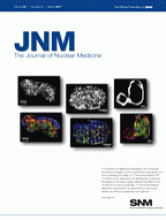Translocator proteins: Scarf and Kassiou provide an overview on TSPOs and the use of PET radioligands to track progression and severity of neuroinflammatory disease and other pathologies.Page 677
Patient release and 131I therapy: Goldsmith questions current regulatory restrictions focused on release of patients after radioiodine therapy and previews an article in this issue of JNM on health care challenges posed by these requirements.Page 681
Delayed 131I therapy and survival: Higashi and colleagues explore the clinical factors affecting survival of patients with differentiated thyroid carcinoma after total thyroidectomy.Page 683
18F-FLT PET and lymphoma prognosis: Herrmann and colleagues correlate initial uptake of 18F-FLT with clinical outcomes in patients with aggressive non-Hodgkin lymphoma treated with rituximab, cyclophosphamide, doxorubicine, vincristine, and prednisone.Page 690

Single CT phases in PET/CT: Ruf and colleagues assess the value of each CT phase (early arterial, portal–venous inflow, and venous) of a triple-phase CT protocol in comparison with 68Ga-DOTATOC PET in diagnosing neuroendocrine tumors.Page 697

18F-FDG PET biology in metastatic tumors: Kaira and colleagues investigate the underlying biologic mechanisms of 18F-FDG uptake in metastatic pulmonary tumors to more fully understand the ability of PET to predict therapeutic response and outcomes.Page 705
Lesion detection in TOF PET: Surti and colleagues evaluate the benefit of fully 3D time-of-flight PET in clinical whole-body oncology using human observers to localize and detect lesions in realistic patient anatomic backgrounds.Page 712

Clinical apoptosis imaging: Höglund and colleagues detail the first-in-humans study with 8F-ML-10, a small-molecule PET tracer for apoptosis.Page 720
Myocardial flow reserve and prognosis: Fukushima and colleagues describe prediction of short-term cardiovascular events using quantification of global myocardial flow reserve in patients referred for clinical 82Rb PET perfusion imaging.Page 726
Combined tracers in degenerative Parkinsonism: Südmeyer and colleagues report on the combined ability of 123I-labeled IBZM, FP-CIT, and MIBG SPECT and a multidimensional statistical algorithm to distinguish idiopathic Parkinson disease from atypical parkinsonian disorder.Page 733
Prostate sentinel nodes: Vermeeren and colleagues evaluate a portable γ-camera for sentinel node identification during laparoscopic sentinel lymphadenectomy for prostate cancer.Page 741
Parametric viability images with 15O-H2O: Harms and colleagues describe the generation of parametric perfusable tissue index images from a 15O-H2O PET/CT scan without an additional 15O-CO scan.Page 745

MPI and preoperative risk stratification: Weinstein and Steingart provide an educational overview of the role of myocardial perfusion imaging in preoperative risk assessment and make recommendations for integration of current guidelines into clinical practice.Page 750
Model of old myocardial infarction: Teramoto and colleagues describe PET studies assessing the pathophysiologic status of a pig model of reduced left ventricular function and remodeling with long survival after myocardial infarction.Page 761
Small-animal PET/CT in osteoporosis: Li and colleagues use PET/CT to analyze the impact of estrogen deficiency osteoporosis on microdamage by observing changes in the uptake of 18F-fluoride in the tibiae of ovariectomized rats after fatigue loading.Page 769

Enhancing 111In-DTPA-hEGF therapy: Cornelissen and colleagues investigate whether the therapeutic efficacy of 111In-labeled human epidermal growth factor is increased by coadministration of selected molecularly targeted drugs that modulate EGF receptor signaling and trafficking.Page 776

Imaging intraprostatic gene transcription: Pouliot and colleagues combine a novel transcriptional amplification system signal with a protocol for tracer administration to demonstrate in vivo PET detection of transcriptional activity in both mouse and immunocompetent canine prostates.Page 784

Small-animal PET of tumor damage: Song and colleagues investigate the potential application of small-molecular-weight 64Cu-labeled bis-DOTA-hypericin for noninvasive assessment of response to photothermal ablation therapy.Page 792

Kinetics and uptake of 18F-FDG in mice: Wong and colleagues explore the effects of dietary condition, blood glucose level, and injection site on kinetics and uptake of 18F-FDG in mice.Page 800

18F-FBnTP and BAT thermogenesis: Madar and colleagues report on an approach to detect brown adipose tissue depots and monitor thermogenesis using a mitochondria-targeting, voltage-sensing PET tracer.Page 808
β-Camera with a microfluidic chip: Vu and colleagues describe an integrated β-camera and microfluidic chip capable of quantitative imaging of glycolysis radioassays using 18F-FDG in small cell populations down to a single cell.Page 815
Transport and fate of anti–18F-FACBC: Okudaira and colleagues provide experimental data clarifying the transport mechanism of this amino acid PET tracer in prostate cancer cells and describe its promise for clinical imaging.Page 822
Opinions about RIT: Schaefer and colleagues report on the results of a survey of nuclear medicine and radiation oncology professionals on opinions and patterns of use of 90Y-ibritumomab tiuxetan and 131I-tositumomab radioimmunotherapy.Page 830
ON THE COVER
Laparoscopic use of a portable γ-camera to identify sentinel nodes during sentinel lymphadenectomy for prostate cancer leads to excision of more radioactive nodes and can determine the residual radioactivity after excision. The image at bottom confirms adequate excision of the sentinel nodes that were identified in the image at top. The injection area is seen caudally in both images.

- © 2011 by Society of Nuclear Medicine







